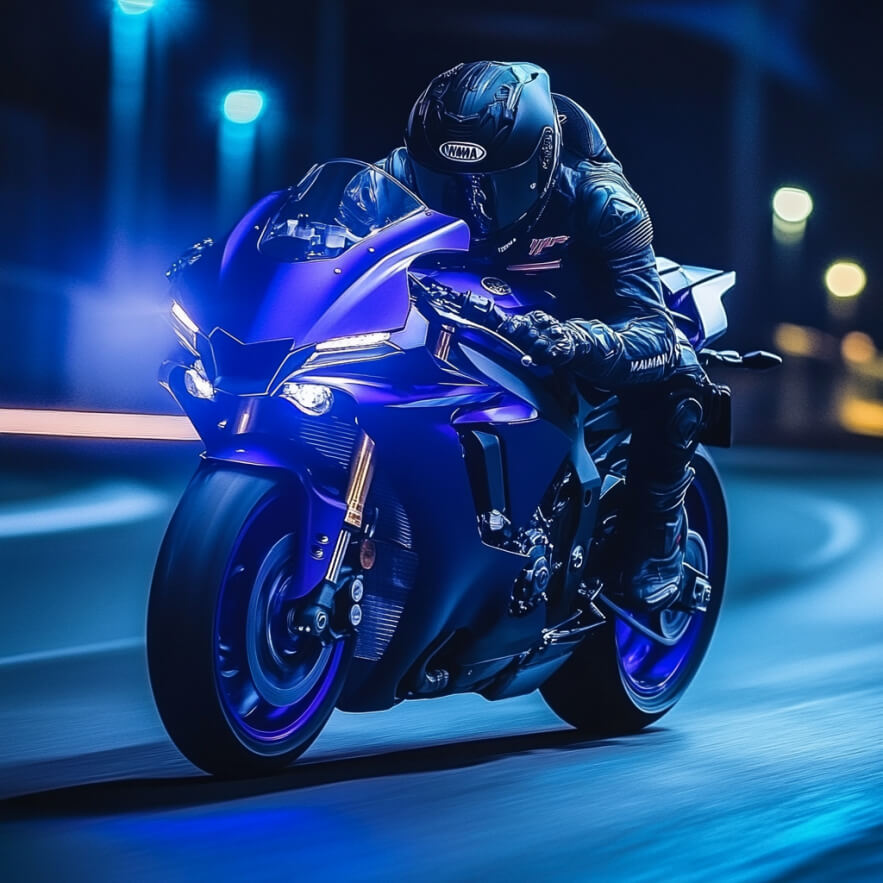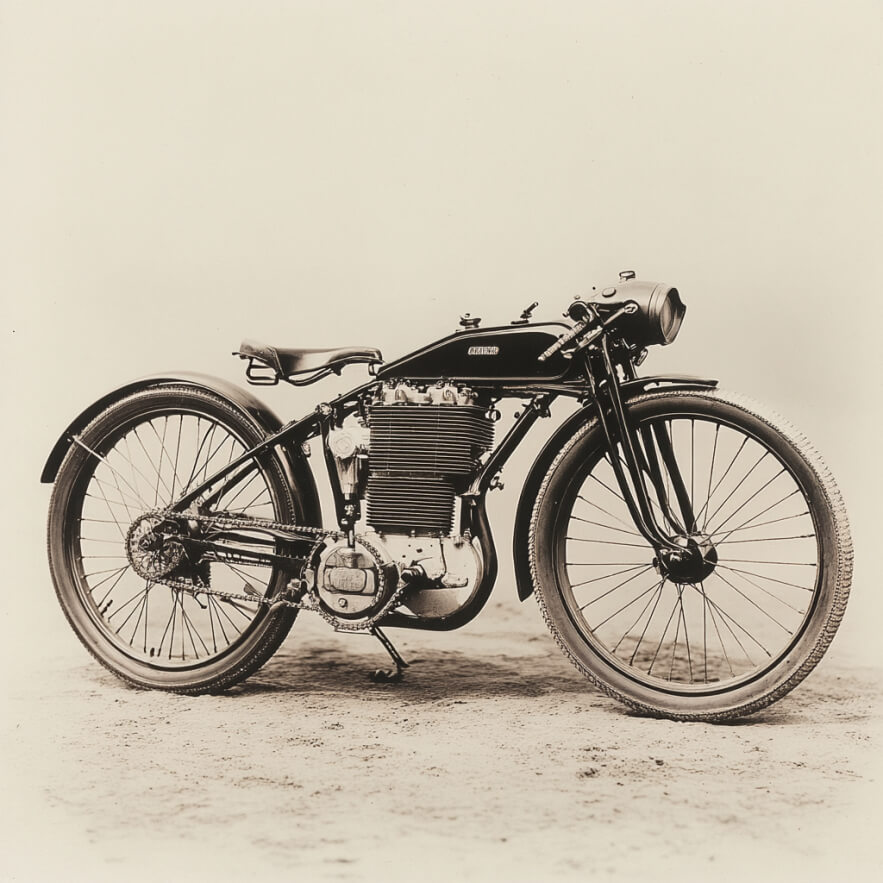Motorbikes have come a long way from their first primitive models to today’s high-tech bikes that can accelerate up to 300 kilometres per hour and are equipped with artificial intelligence. It’s important to understand exactly how this transformation took place in order to better understand the modern motorbike industry.
The emergence of the first motorbikes
The first prototype of a motorbike is considered to be a steam-powered two-wheeled vehicle created in 1869 by the American Sylvester Roper. However, the real breakthrough was the invention of the Daimler Reitwagen in 1885 – this machine, equipped with a petrol engine, became the ancestor of all modern bikes.
Development of the internal combustion engine
At the beginning of the 20th century, the motorbike industry began to grow rapidly. In 1903, Harley-Davidson launched its first motorbike, and in 1923 BMW introduced the legendary R32 with side-mounted cylinders. Subsequently, the emergence of Japanese giants such as Honda, Yamaha and Suzuki led to a revolution in the industry.
A new era of technology
Modern motorbikes are not just machinery, but high-tech machines equipped with traction control systems, semi-automatic gearboxes, adaptive lighting and electronic suspensions, making them safer and easier to control. The development of electric and hydrogen engines opens up new horizons, making motorbikes not only more powerful but also more environmentally friendly.
Technological advances are not only affecting the designs of the motorbikes themselves, but also the economic side of motorcycling. In the pursuit of speed and efficiency, teams are adopting new financial technologies: for example, some teams have started accepting sponsorship payments in cryptocurrency, and riders receive their fees via digital assets, eliminating delays in international payments. This optimises budgets and facilitates financial transactions, which is particularly important in the dynamic world of modern racing.
The main types of motorbikes and their features
The choice of motorbike depends on the rider’s riding style, operating conditions and preferences. Different types of bikes have their unique features, advantages and disadvantages.
Classic motorbikes
Classic bikes are versatile machines designed for comfortable riding in urban conditions and for medium distances. They are characterised by an upright riding position, balanced power and ease of operation.
Popular models:
- BMW R NineT
- Honda CB750
- Yamaha XJR1300
Sportbikes
Sportbikes are high-tech machines designed for high speeds and aggressive riding styles. They feature lightweight materials in construction, powerful engines and aerodynamic dodging.
Key features:
- High power and engine revs
- Stiff suspension and aggressive stance
- Aerodynamic design to minimise drag
Examples of sportbikes:
- Yamaha YZF-R1
- Kawasaki Ninja H2
- Ducati Panigale V4
Touring motorbikes
These bikes are designed for long journeys, providing maximum comfort through comfortable seating, a large windscreen and advanced ergonomics.
What distinguishes touring bikes?
- Roomy cases and luggage systems
- Advanced navigation system and heated grips
- Larger tank for high mileage
Popular models:
- Honda Gold Wing
- BMW K1600GT
- Harley-Davidson Electra Glide
Cruisers and Choppers
Cruisers are low-slung motorbikes with wide handlebars and a powerful engine, designed for comfortable urban riding and long-distance travelling. Choppers, on the other hand, feature customised designs and unique geometry.
The iconic models are:
- Harley-Davidson Softail
- Indian Chief
- Honda Shadow
Enduro and cross bikes
These bikes are designed for unarmoured roads, off-road racing and extreme conditions. They feature a lightweight frame, high suspension and durable tyres.
Distinctive features:
- High ground clearance and long suspension travel
- Heavy-duty engine and frame protection
- Low weight for better manoeuvrability
Popular models:
- KTM 450 EXC-F
- Honda CRF450L
- Yamaha WR450F

Innovation in the world of motorbikes: current technologies and trends
The motorbike industry is rapidly evolving, offering riders new technologies that increase power, comfort and safety. In recent years, advances in electronics and alternative engines have been particularly noticeable.
Smart control systems
Modern motorbikes are equipped with traction control, electronic suspension control, automatic brake force control and even adaptive cruise control. These technologies can significantly improve rider safety.
Developments in electric transport
Electric motorbikes are no longer inferior to petrol bikes in terms of power and acceleration dynamics. Zero, Harley-Davidson (LiveWire) and Energica are actively developing this segment.
Advantages of electric motorbikes:
- Eco-friendliness
- High torque from zero revs
- No need for oil and fuel changes
Innovative materials and design
Modern motorbikes are made of carbon, titanium and aircraft aluminium, making them lightweight and strong. New designs, such as aerodynamic fenders and active skirts, help to improve handling.
Motorbike tuning: from aesthetics to boosting power
Tuning is not only a way to express your individuality, but also an opportunity to improve the technical performance of your motorbike. There are many ways to modernise your bike.
Improving the engine and exhaust system
One of the most popular areas is to increase engine power by re-flashing the ECU, installing a new air filter and tuning the exhaust.
Popular modifications:
- Installing a sport exhaust to increase torque
- Replacing the air filter with a more efficient one
- Tuning the fuel map to improve throttle response
Visual tuning and customisation
For those who want to stand out, there are various customisation options such as airbrushing, custom lighting, replacing plastics and adding new design elements.
What can be customised?
- Install LED optics
- Paint the frame and plastic in unique colours
- Replace the dashboard with a digital dashboard
Motorbike tuning is a process that makes the bike not only more powerful, but also more expressive, emphasising the rider’s style.
FAQ
In 1869 by Sylvester Roper
Daimler in 1885 (Daimler Reitwagen)
Traction control, electronic suspension, adaptive lighting, semi-automatic transmissions.
Eco-friendliness, high torque, no need for oil changes or fuel refills.

